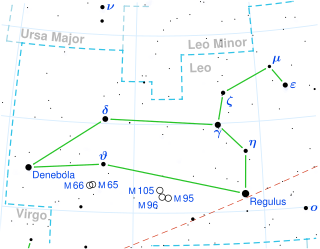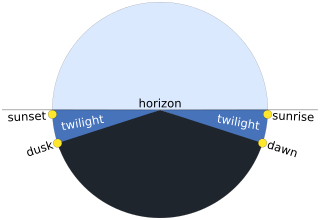A day is the time period of a full rotation of the Earth with respect to the Sun. On average, this is 24 hours. As a day passes at a given location it experiences morning, noon, afternoon, evening, and night. This daily cycle drives circadian rhythms in many organisms, which are vital to many life processes.

The Solar System is the gravitationally bound system of the Sun and the objects that orbit it. It was formed 4.6 billion years ago when a dense region of a molecular cloud collapsed, forming the Sun and a protoplanetary disc. The Sun is a main-sequence star, where hydrogen in its core is fused into helium. Most of fusion energy is released into space as electromagnetic radiation (light) and neutrinos.

The zodiacal light is a faint glow of diffuse sunlight scattered by interplanetary dust. Brighter around the Sun, it appears in a particularly dark night sky to extend from the Sun's direction in a roughly triangular shape along the zodiac, and appears with less intensity and visibility along the whole ecliptic as the zodiacal band. Zodiacal light spans the entire sky and contributes to the natural light of a clear and moonless night sky. A related phenomenon is gegenschein, sunlight backscattered from the interplanetary dust, appearing directly opposite to the Sun as a faint but slightly brighter oval glow.

Pallas is the second asteroid to have been discovered, after Ceres. Like Ceres, it is believed to have a mineral composition similar to carbonaceous chondrite meteorites, though significantly less hydrated than Ceres. It is the third-largest asteroid in the Solar System by both volume and mass, and is a likely remnant protoplanet. It is 79% the mass of Vesta and 22% the mass of Ceres, constituting an estimated 7% of the mass of the asteroid belt. Its estimated volume is equivalent to a sphere 507 to 515 kilometers in diameter, 90–95% the volume of Vesta.
The heliacal rising of a star or a planet occurs annually when it first becomes visible above the eastern horizon at dawn just before sunrise after a complete orbit of the Earth around the Sun. Historically, the most important such rising is that of Sirius, which was an important feature of the Egyptian calendar and astronomical development. The rising of the Pleiades heralded the start of the Ancient Greek sailing season, using celestial navigation, as well as the farming season. Helical rising is one of several types of risings and settings, mostly they are grouped into morning and evening risings and settings of objects in the sky. Culmination in the evening and then morning is set apart by half a year, while on the other hand risings and settings in the evenings and the mornings are only at the equator set apart by half a year.

Sunrise is the moment when the upper rim of the Sun appears on the horizon in the morning. The term can also refer to the entire process of the solar disk crossing the horizon.

Dawn is the time that marks the beginning of twilight before sunrise. It is recognized by the appearance of indirect sunlight being scattered in Earth's atmosphere, when the centre of the Sun's disc has reached 18° below the observer's horizon. This morning twilight period will last until sunrise, when direct sunlight outshines the diffused light.
In astronomy, an epoch or reference epoch is a moment in time used as a reference point for some time-varying astronomical quantity. It is useful for the celestial coordinates or orbital elements of a celestial body, as they are subject to perturbations and vary with time. These time-varying astronomical quantities might include, for example, the mean longitude or mean anomaly of a body, the node of its orbit relative to a reference plane, the direction of the apogee or aphelion of its orbit, or the size of the major axis of its orbit.

Regulus is the brightest object in the constellation Leo and one of the brightest stars in the night sky. It has the Bayer designation designated α Leonis, which is Latinized to Alpha Leonis, and abbreviated Alpha Leo or α Leo. Regulus appears singular, but is actually a quadruple star system composed of four stars that are organized into two pairs. The spectroscopic binary Regulus A consists of a blue-white main-sequence star and its companion, which has not yet been directly observed, but is probably a white dwarf. The system lies approximately 79 light years from the Sun.

Night or nighttime is the period of ambient darkness when the Sun is below the horizon.

The vulcanoids are a hypothetical population of asteroids that orbit the Sun in a dynamically stable zone inside the orbit of the planet Mercury. They are named after the hypothetical planet Vulcan, which was proposed on the basis of irregularities in Mercury's orbit that were later found to be explained by general relativity. So far, no vulcanoids have been discovered, and it is not yet clear whether any exist.

Twilight is light produced by sunlight scattering in the upper atmosphere, when the Sun is below the horizon, which illuminates the lower atmosphere and the Earth's surface. The word twilight can also refer to the periods of time when this illumination occurs.

The night sky is the nighttime appearance of celestial objects like stars, planets, and the Moon, which are visible in a clear sky between sunset and sunrise, when the Sun is below the horizon.

Evening is the period of a day that begins at the end of daylight and overlaps with the beginning of night. It generally indicates the period of time when the sun is close to the horizon and comprises the periods of civil, nautical and astronomical twilight. The exact times when evening begins and ends are subjective and depend on location and time of year. It may be used colloquially to include the last waning daytime shortly before sunset.
The interplanetary dust cloud, or zodiacal cloud, consists of cosmic dust that pervades the space between planets within planetary systems, such as the Solar System. This system of particles has been studied for many years in order to understand its nature, origin, and relationship to larger bodies. There are several methods to obtain space dust measurement.

Discovery and exploration of the Solar System is observation, visitation, and increase in knowledge and understanding of Earth's "cosmic neighborhood". This includes the Sun, Earth and the Moon, the major planets Mercury, Venus, Mars, Jupiter, Saturn, Uranus, and Neptune, their satellites, as well as smaller bodies including comets, asteroids, and dust.

The Great Comet of 1901, sometimes known as Comet Viscara, formally designated C/1901 G1, was a comet which became bright in the spring of 1901. Visible exclusively from the southern hemisphere, it was discovered on the morning of April 12, 1901 as a naked-eye object of second magnitude with a short tail. On the day of perihelion passage, the comet's head was reported as deep yellowish in color, trailing a 10-degree tail. It was last seen by the naked eye on May 23.

C/2012 F6 (Lemmon) is a long-period comet discovered in Leo on 23 March 2012, by A. R. Gibbs using the 1.5-m reflector at the Mt. Lemmon Survey, located at the summit of Mount Lemmon in the Santa Catalina Mountains north of Tucson, Arizona, USA. Initially, the object was considered to be of asteroidal nature before later observations confirmed its cometary appearance. Comet Lemmon has a highly eccentric orbit, bringing it as close to 0.73 AU from the Sun at perihelion and as far as 973 AU from the Sun at aphelion. This also leads to the comet's long-period nature with an orbital period of approximately 8,000 years based on epoch 2050. The comet last reached perihelion on 24 March 2013.
Maya astronomy is the study of the Moon, planets, Milky Way, Sun, and astronomical phenomena by the Precolumbian Maya Civilization of Mesoamerica. The Classic Maya in particular developed some of the most accurate pre-telescope astronomy in the world, aided by their fully developed writing system and their positional numeral system, both of which are fully indigenous to Mesoamerica. The Classic Maya understood many astronomical phenomena: for example, their estimate of the length of the synodic month was more accurate than Ptolemy's, and their calculation of the length of the tropical solar year was more accurate than that of the Spanish when the latter first arrived. Many temples from the Maya architecture have features oriented to celestial events.

594913 ꞌAylóꞌchaxnim (provisional designation 2020 AV2) is a large near-Earth asteroid discovered by the Zwicky Transient Facility on 4 January 2020. It is the first asteroid discovered to have an orbit completely within Venus's orbit, and is thus the first and only known member of the eponymous ꞌAylóꞌchaxnim (informally named Vatira before its discovery) population of Atira-class asteroids. ꞌAylóꞌchaxnim has the smallest known aphelion and third-smallest known semi-major axis among all asteroids. With an absolute magnitude approximately 16.2, the asteroid is expected to be larger than 1 km in diameter.

















